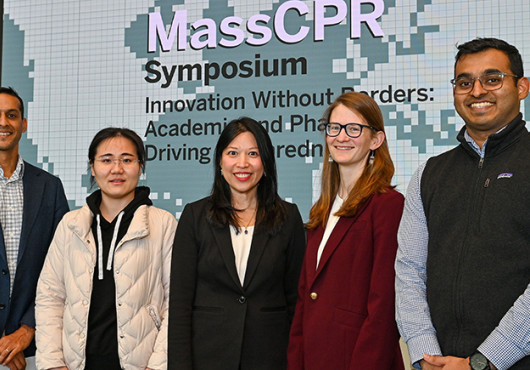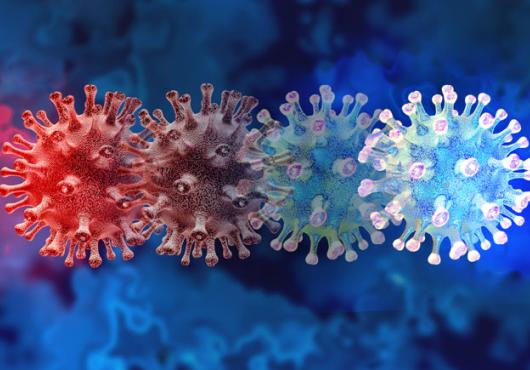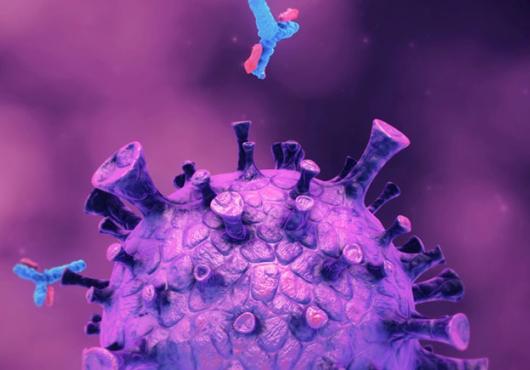This article is part of Harvard Medical School’s continuing coverage of COVID-19.
As the world enters year four of the COVID-19 pandemic, scientists have amassed a great deal of knowledge about the biology and behavior of SARS-CoV-2 and about the clinical features of the disease that it causes. They have also developed an impressive arsenal of treatments.
Yet, as the shapeshifting pathogen churns out one new variant after another, COVID remains an elusive foe, causing new and repeat infections and raising new questions about who should be treated, how, and when.
Priming the body’s defenses
Vaccines are the proverbial ounce of prevention that may save a pound of treatment, resarchers say, because they lay the body’s immune-defense foundation by stimulating two overlapping lines of protection: antibodies, which reduce the chance of infection in the first place, and T cells, which shield against serious disease and prevent severe symptoms should an infection occur.
Vaccines — technically, a form of prevention rather than treatment — remain the single best protection against serious illness, hospitalization, and death, experts say.
Science & Medicine, Delivered
Harvard Medicine magazine in your inbox
And even though the original COVID vaccines may have lost some of their punch against the new variants, they are holding up very well against severe illness and death, said Kathryn Stephenson, assistant professor of medicine at Harvard Medical School and an infectious disease expert at Beth Israel Deaconess Medical Center, at a recent news briefing. Topping up this preexisting immunity with the omicron-updated boosters should further enhance protection, Stephenson added. Even though the studies are still ongoing, data suggest that the omicron-specific boosters enhance immunity against variants.
A recent Commonwealth Fund analysis estimated that if rates of receiving COVID vaccine boosters reached levels comparable to those of the flu vaccine, the U.S. could save an additional 75,000 lives over a mere three months. That number goes up to nearly 90,000 lives saved over three months if 80 percent of those eligible receive boosters. Yet, booster vaccination is lagging.
“We can argue about the modeling but it’s pretty clear that even when we make modest assumptions, you still save lives,” said Peter Marks, director of the Center for Biologics Evaluation and Research (CBER) at the U.S. Food and Drug Administration at a recent scientific symposium organized by the HMS-led Massachusetts Consortium on Pathogen Readiness (MassCPR).
The U.S. Centers for Disease Control and Prevention currently recommends waiting two months between infection or a prior COVID vaccine before getting the bivalent booster. Boosters are particularly critical for individuals 65 and older, in whom vaccine immunity wanes faster.
If and when an infection occurs, the two common questions are whether current treatments still hold up against the new variants and whether vaccinated people benefit from treatment, said Jonathan Li, associate professor of medicine at HMS and director of the Harvard/Brigham Virology Specialty Laboratory.
The answer to both questions is yes, but with some qualifiers.
Are current therapies weakened by new variants?
Some, but not all. The antiviral pill Paxlovid seems to be working against the new variants, Li said. But the news is far less encouraging for monoclonal antibodies.
All five monoclonal antibodies approved by the FDA have lost their potency against the currently dominant omicron subvariants — BQ.1 and BQ.1.1, Li said. And yet another omicron subvariant, XBB, has entered the scene and is rapidly gaining ground.
This leaves only three working antiviral therapies — Paxlovid, remdesivir, and molnupiravir. These treatments continue to be effective against emerging subvariants, but each has drawbacks, Li cautioned.
For example, Paxlovid has high efficacy and is easy to dose and deliver as a three-pill-a-day regimen for five days, but in some patients, it can cause viral rebound and interfere with other medications, Li cautioned. A rebound is defined as the return of symptoms and/or testing positive after finishing the full course of medication and after testing negative. If this happens, patients should return to isolation because they may be shedding infectious virus until they test negative again.
Remdesivir also remains effective but requires three consecutive days of IV infusion. Molnupiravir is easy to deliver in pill form, but its efficacy is lower compared with Paxlovid.
Given this dwindling treatment arsenal, Li urged fellow researchers to “start digging a little deeper into our toolbox.”
Treatments under investigation include novel protease inhibitors — medications that prevent the virus from making copies of itself by not allowing it to cut certain proteins — as well as an oral form of remdesivir that is entering phase 3 trials.
For hospitalized patients with severe disease, the new variants have not changed treatment protocols. This is because critical illness after SARS-CoV-2 infection generally stems not from the virus itself but from the host’s aberrant immune response, which generally occurs well after the virus has stopped replicating, said Eric Rubin, editor-in-chief of The New England of Journal Medicine and HMS professor of medicine at Brigham and Women’s Hospital, during a recent NEJM podcast. Thus, treatments in critically ill patients are generally directed at curbing runaway inflammation with corticosteroids and other agents that block inflammation along with prophylactic anticlotting medications or, in case of organ involvement, with organ-specific supportive therapies.
“Fortunately, we’re seeing a far smaller number of patients that require these treatments,” Rubin said.
Vaccinated but with COVID: Now what?
Vaccinated people younger than 65 who are in good overall health may not derive additonal benefit from antivirals, Li said, because their immune systems are already well primed by the vaccine. Yet, even younger people with prior immunity could benefit from antivirals if they have multiple risk factors for severe disease, such as diabetes, hypertension, or asthma.
Treatment is recommended for people at risk for severe COVID, including unvaccinated individuals, people older than 65, those with weakened immune systems, and people with accompanying conditions such as hypertension, diabetes, and various forms of heart and lung diseases.
Older people, regardless of vaccine status or prior immunity from natural infection, derive clear benefit from antivirals, according to a large study from Israel. The protective effect of antivirals against severe disease appears to be even more pronounced among unvaccinated individuals, regardless of age, according to the study. Those under age 65 who had no immunity from vaccination or from a prior infection were 77 percent less likely to end up in the hospital and to die, than those not treated with antivirals, the study found. Among nonvaccinated, nonimmune people age 65 and older, antivirals reduced the risk of hospitalization and death by 85 percent, compared with nonvaccinated infected individuals who did not get antivirals.
For treating long COVID, a long road ahead
Long COVID presents one of the most confounding mysteries of the disease, raising many questions with few answers. Most importantly, researchers do not understand the underlying mechanism behind the syndrome, which makes it hard to treat at the root.
“We have a lot of unanswered questions about this new syndrome: What’s the case definition? What are the disease-driving mechanisms? Who’s at greatest risk, what’s the right care and what’s the prognosis?” said Bruce Levy, co-lead of the long COVID research arm of MassCPR, the HMS Parker B. Francis Professor of Medicine and chief of the Division of Pulmonary and Critical Care Medicine at Brigham and Women’s.
Answers to some of those questions have started to crystallize, but most remain murky.
For example, after much initial debate about the definition of long COVID, the CDC and the World Health Organization have now begun to converge on a definition: any lingering symptoms or the emergence of new symptoms four weeks after initial infection should be deemed long COVID. Estimates of prevalence vary widely, but even at the modest end, the numbers are alarmingly high. The CDC estimates that one in five adults infected with SARS-CoV-2 goes on to develop long COVID symptoms.
Multiple organs and organ systems can be involved. Levy said the most commonly reported symptoms he and colleagues see in their long COVID clinics involve neurologic symptoms (memory loss, dizziness, brain fog, headache), respiratory dysfunction (shortness of breath, fatigue) and cardiovascular aberrations (palpitations, chest pain, blood clots).
Certain clues have also emerged on the risk-prediction front. People with severe COVID who end up in intensive care are more likely to develop long COVID following recovery. So are older adults, regardless of how severe their initial infection was. More women than men report long COVID symptoms, hinting at sex-hormone differences in risk. Conditions such as respiratory diseases, diabetes, and obesity also seem to raise the risk for long-term complications. Vaccines, on the other hand, seem to reduce the risk of developing the condition — research suggests that long COVID symptoms occur at a lower rate among vaccinated than unvaccinated individuals, but researchers caution that the finding needs to be affirmed in further studies.
The most critical challenge that lies ahead for physician-scientists will be to untangle the mechanism — or multiple mechanisms — that underlie the development of long COVID, Levy said.
More than one mechanism may be at play, and long COVID may result from different pathways in different patients.
Scientists hypothesize that long COVID may arise from mechanisms that fall into two broad categories: the host’s response to infection and the virus itself.
For example, in some people long COVID may arise after SARS-CoV-2 infection reactivates another virus that infects the host chronically and lies dormant in the body until reawakened, such as Epstein-Barr or cytomegalovirus. Yet in other people, long COVID may be the result of an autoimmune response or persistent inflammation. In still others it could be triggered by the ongoing formation of microclots stemming from changes in the small blood vessels throughout the body, a process that can lead to organ damage.
Without understanding the fundamental mechanisms of the disease, Levy said, scientists cannot design treatments that precision-target the underlying causes that fuel it.
Aside from the need for specific insights into the pathogenesis of long COVID, the best way to deal with the still-unfolding mystery of the virus and the disease is to follow scientific first principles unwaveringly, said Lindsey Baden, HMS professor of medicine and vice president of clinical research at Brigham and Women’s.
“Just follow the science — it doesn’t seem complicated, but it doesn’t always happen,” Baden said. “We have to stay vigilant to the pathogen evolution, stay vigilant to the disease evolution — which can be remote from the viral infection — and we have to remember the value of collaboration and cross-disciplinary insight.”





